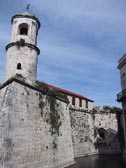EXCLUSIVE: Why is the 6th annual STC so important to the Caribbean?
 Ben Kilbey
Ben Kilbey
If the Caribbean is to survive then its people, as well as its visitors, must be aware of the rich tapestry and diversity of its eco-systems and natural resources. In a bid to gain awareness of these matters the 6th annual Sustainable tourism conference is set to be hosted in the Cuban capital of Havana (April 27th to 30th, 2004). Its aim is to make the region aware of what is necessary to ensure that what is protected today is still available for tomorrow and tomorrow’s children.In order to do so the conference is to run on a tight schedule with key speakers from various islands displaying projects that they have already undertook and are implementing, or those that they are initiating for the future.
“KEEPING THE RIGHT BALANCE - LAND AND SEA ENCOUNTERS” is the theme of this year’s Conference, recognising that Caribbean development converges on coastal areas.
Most Caribbean states and territories are small islands, and in the case of the continental countries of the region, an important percentage of their population and economic activities are located near or on Caribbean coasts.
The delicate balance between land and sea ecosystems in coastal areas is being affected by several human activities in the Caribbean, tourism being one of the most important for the region.
The conference will look at how land and sea-based activities are affecting the sustainability of coastal areas and consequently, the planning and conservation efforts necessary for the sustainable development of tourism.
A series of national, regional and international best practices (case studies) will be presented at the Conference to analyse the critical issues pertaining to the sustainable development of tourism in coastal areas. Natural and heritage-based tourism products; protected areas and community participation will be the special areas of focus of the Conference, utilising the host country, Cuba, as one of the case studies.
“This is an exciting conference to attend, and this year’s line up is of a very high caliber,” noted one CTO representative. “Last years event, hosted on the beautiful Caribbean island of St. Kitts, was a wonderful success and the Caribbean has certainly benefited from the case studies put forward. We hope that this year’s event will cause even more change and bring more benefits to the region.”
The event is a superb opportunity for international journalists to learn how important Sustainable tourism is to the region and the dangers of what may occur if certain actions are not taken, sooner rather then later. It is also an ideal opportunity to witness the measures that the Cuban authorities have taken in order to preserve their heritage.
Havana was founded in 1519 by the Spanish. By the 17th century, it had become one of the Caribbean’s main centres for ship-building. Although it is today a sprawling metropolis of 2 million inhabitants, its old centre retains an interesting mix of Baroque and neoclassical monuments, and a homogeneous ensemble of private houses with arcades, balconies, wrought-iron gates and internal courtyards.
 What is known today as the historical centre of Havana includes the area of the original quarter enclosed by the city walls. On a surface area of 214 hectares, 4,000 buildings (900 of which are of high heritage value) are spread throughout 242 city blocks. However, the overall condition of Old Havana’s buildings is alarming. Many are crumbling with infrastructures in an advanced stage of decay.
What is known today as the historical centre of Havana includes the area of the original quarter enclosed by the city walls. On a surface area of 214 hectares, 4,000 buildings (900 of which are of high heritage value) are spread throughout 242 city blocks. However, the overall condition of Old Havana’s buildings is alarming. Many are crumbling with infrastructures in an advanced stage of decay.
Realising that they were in danger of losing their heritage, the Cuban authorities created a Historian of the City position in 1925, and in 1938 the Office of the Historian of the City of Havana was instituted. At first, it was a struggle to safeguard monuments and historic sites from destruction.
ADVERTISEMENT
After the revolution, the Office was recognised as an important tool to save the country’s heritage. In 1982, UNESCO declared Old Havana as part of the cultural heritage of humanity. At the same time major restoration work in various squares, historical streets and especially the Tres Reyes del Moro and San Carlos fortresses began.
With the collapse of the Soviet Union almost all restoration efforts ground to a halt. In the early 90’s the Cuban government confirmed its commitment to preserving their heritage by giving special powers to the Office of the Historian of the City of Havana. Since then, the Office has been responsible for the administration, restoration, and development of the historic centre.
This is one indication of self-preservation in the Caribbean isles. The conference aims to show case many others. For more information on the conference and to find out how to register visit the CTO’s website: www.onecaribbean.org
——-

